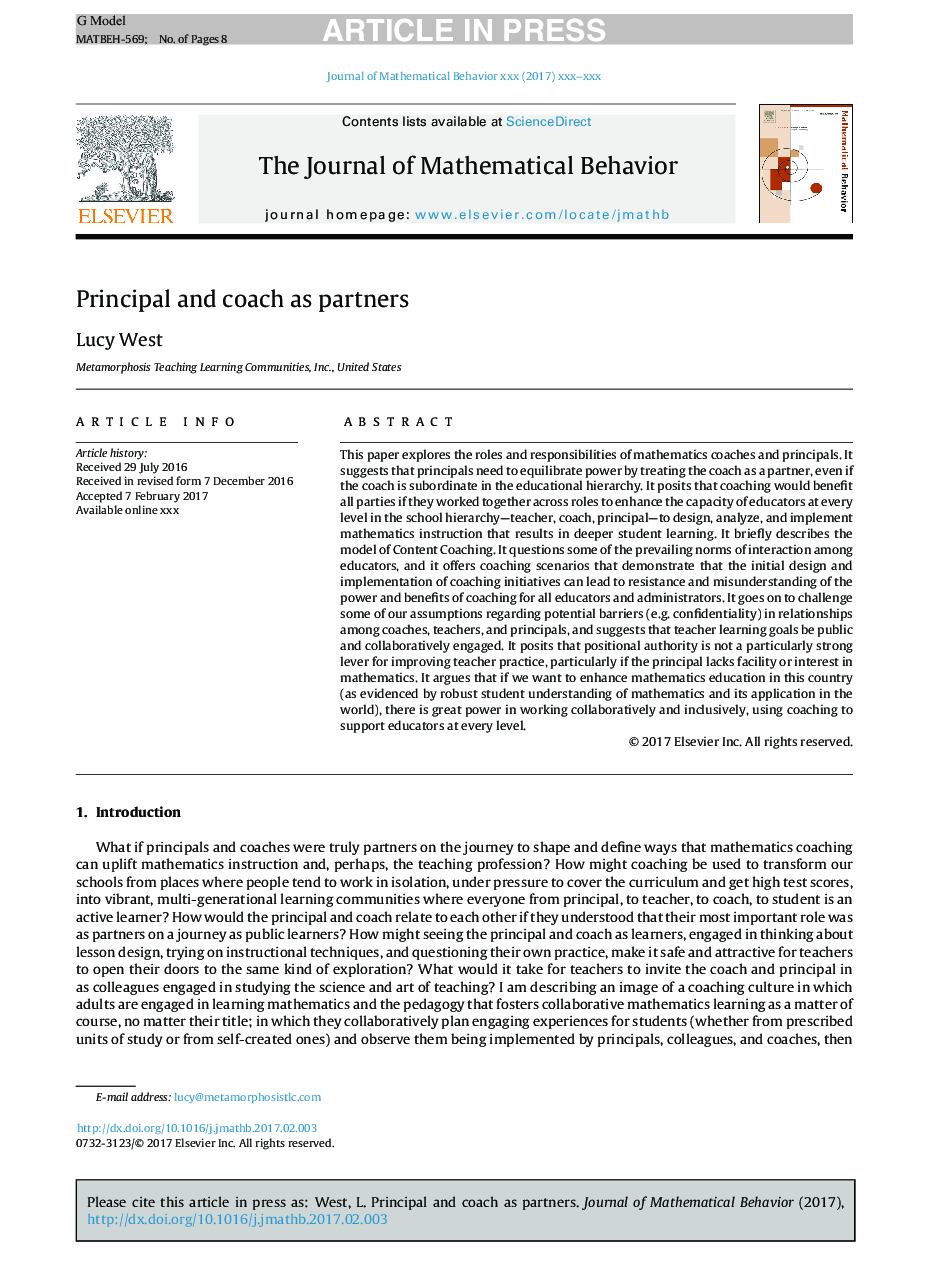| کد مقاله | کد نشریه | سال انتشار | مقاله انگلیسی | نسخه تمام متن |
|---|---|---|---|---|
| 4939314 | 1436004 | 2017 | 8 صفحه PDF | دانلود رایگان |
عنوان انگلیسی مقاله ISI
Principal and coach as partners
ترجمه فارسی عنوان
سرپرست و مربی به عنوان همکار
دانلود مقاله + سفارش ترجمه
دانلود مقاله ISI انگلیسی
رایگان برای ایرانیان
ترجمه چکیده
این مقاله نقش و مسئولیت مربیان ریاضی و مدیران را بررسی می کند. این نشان می دهد که مدیران باید با رفتار مربی به عنوان یک شریک، حتی اگر مربی در سلسله مراتب آموزشی زیر سلطه داشته باشد، نیاز به تعادل دارد. این نشان می دهد که مربیگری به نفع همه طرف ها خواهد بود اگر آنها با یکدیگر در نقش ها کار کنند تا ظرفیت مربیان را در هر سطح در سلسله مراتب مدرسه، معلم، مربی، مدیر اصلی، طراحی، تجزیه و تحلیل و اجرای دستورالعمل های ریاضی را که به یادگیری دانش آموزان عمیق تر کمک می کند، افزایش دهد. این به طور خلاصه مدل مربیگری محتوا را توصیف می کند. این سؤال برخی از هنجارهای غالب تعامل میان مربیان است و ارائه سناریوهای مربیگری را نشان می دهد که نشان می دهد طراحی اولیه و اجرای ابتکارات مربیگری می تواند منجر به مقاومت و سوء تفاهم قدرت و مزایای مربیگری برای همه مربیان و مدیران شود. این موضوع به برخی از فرضیه های ما در مورد موانع بالقوه (مثلا محرمانه بودن) در روابط بین مربیان، معلمان و مدرسان چالش می زند و پیشنهاد می کند که اهداف یادگیری معلمان به صورت عمومی و با هم مشارکت داشته باشند. این امر نشان می دهد که اقتدار موقعیتی یک نیروی قوی برای بهبود عملکرد معلم نیست، بویژه اگر مدیر اصلی یا علاقه مند به ریاضیات نداشته باشد. این استدلال می کند که اگر ما بخواهیم آموزش ریاضیات در این کشور را افزایش دهیم (همانگونه که درک دانش آموزان از ریاضیات و کاربرد آن در جهان است)، توانایی کار در همکاری و همگانی با استفاده از مربیگری برای حمایت از مربیان در هر سطح وجود دارد.
موضوعات مرتبط
مهندسی و علوم پایه
ریاضیات
ریاضیات کاربردی
چکیده انگلیسی
This paper explores the roles and responsibilities of mathematics coaches and principals. It suggests that principals need to equilibrate power by treating the coach as a partner, even if the coach is subordinate in the educational hierarchy. It posits that coaching would benefit all parties if they worked together across roles to enhance the capacity of educators at every level in the school hierarchy-teacher, coach, principal-to design, analyze, and implement mathematics instruction that results in deeper student learning. It briefly describes the model of Content Coaching. It questions some of the prevailing norms of interaction among educators, and it offers coaching scenarios that demonstrate that the initial design and implementation of coaching initiatives can lead to resistance and misunderstanding of the power and benefits of coaching for all educators and administrators. It goes on to challenge some of our assumptions regarding potential barriers (e.g. confidentiality) in relationships among coaches, teachers, and principals, and suggests that teacher learning goals be public and collaboratively engaged. It posits that positional authority is not a particularly strong lever for improving teacher practice, particularly if the principal lacks facility or interest in mathematics. It argues that if we want to enhance mathematics education in this country (as evidenced by robust student understanding of mathematics and its application in the world), there is great power in working collaboratively and inclusively, using coaching to support educators at every level.
ناشر
Database: Elsevier - ScienceDirect (ساینس دایرکت)
Journal: The Journal of Mathematical Behavior - Volume 46, June 2017, Pages 313-320
Journal: The Journal of Mathematical Behavior - Volume 46, June 2017, Pages 313-320
نویسندگان
Lucy West,
